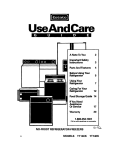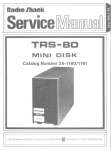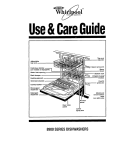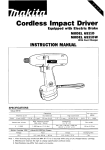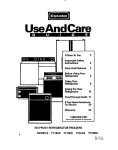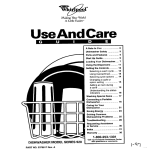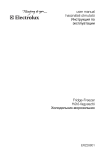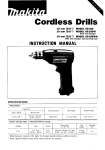Download Whirlpool lT20BK Operating instructions
Transcript
Useand CareGuide No-Frost Refrigerator-Freezer TTI 4CK TT14EK TTI 6CK TTI 6DK TT18EK TT18CK TT20AK TT2OBK Thank you for choosing Estate Appliance. This Use and Care Guide will help you operate and maintain your new, quality-built refrigerator. Keep this Use and Care Guide in a safe place for future reference. Please complete and mail the Owner Registration Card provided with this product. Then complete the form below. Have this information ready if you need service or call with a question. Copy model and serial numbers from label (see diagrams on pages 3, 4 and 5) and purchase date from sales slip. Keep this book and sales slip together in a handy place. l l an You are responsible l l l l l l l Model Number Serial Number for It is your responsibility to be sure your refrigerator: Has been properly installed and leveled according to the installation instructions given on pages 2 and 3. Is installed on a floor that can support the weight of the refrigerator. Is properly connected to a grounded electrical circuit that meets the electrical requirements on page 2. Is properly used only for the job if was designed to do. Is not used by children or anyone unable to operate it properly. Is cold in both the refrigerator and freezer sections before food is added. Is properly maintained. NOTE: Because this Use and Care Guide covers several models, not all features discussed will apply to your specific model. Contents Pnntnmte Important Safety Instructions Before Using Your Refrigerator Parts and Features lTl4CK and TTiGDK TT16CK TT14EKand TTl8EK TT18CK T-POAK lT20BK Using Your Refrigerator Setting the controls Changing control settings Exterior moisture control Adjusting refrigerator shelves Removing meal drawer and cover -7 Removing trivet and mver Removing crispers and crisper cover Removing freezer shelf --7 Removing the base grille Ice cube trays Optional automatic ice maker Changing light bulb(s) Reversing the door swing Energy saving tips Normal operating sounds Food Storage Purchase -2 Guide Cleaning Your Refrigerator Date Caring For Your Refrigerator Service Company Phone Number If ekclricity goes off -Zli Vacation and moving guide Before You Call For Service If YOU Need Assistance, Service or ,vice Or Replacement Park -~ Warranty 2 -2 .* 3 3 4 4 5 5 5 6 6 6 6 6 7 7 7 7 7 6 86 8a 8 a a 9 10 11 11 111 12 13 13 16j Important Safety Instructions To reduce the rlsk of fire, electrical follow basic precautions lncludlng 1. Read all operating instructions before using your refrigeratorfreezer. 2. Child entrapment and suffocations are not problems of the past. Junked or abandoned refrigerators are still dangerous .. . even if they will “just sit in the garage for a few days.” shock, or Injury when using your refrigerator-freezer, the followlng: tl you are getting rid of your old refrigerator, do it safely. Please read the enclosed safety booklet from the Association of Home Appliance Manufacturers. Help prevent accidents. 3. Never allow children to operate, play with, or crawl inside the refrigerator. 4. Never clean refrigerator parts witk flammable fluids. The fumes can create a fire hazard or explosion. . FOR YOUR SAFETY DO NOT STORE OR USE GASOLINE OR OTHER FLAMMABLE VAPORS AND UQUIDS IN THE VlClNfTY OF THIS OR ANY OTHER APPLlANCE. THE FUMES CAN CREATE A FfRE HAZARD OR EXPLOSION. l SAVE THESE INSTRUCTIONS I Before Using Your Refrigerator A. Remove D. Install properly E. Level refrigerator-freezer Install the refrigerator aazording to the dimensions shown below. Leave extra space along the hinge-side wall to allow the door to be opened wider. Do not install the refrigerator: next to an oven, radiator or other heat source; out in the weather or direct sunlight; in an area where the room temperature will fall below 55°F (13%). Follow the leveling instructions for your refrigerator model. Make sure the refrigerator is level for efficient operation. labels Remove the tape and any inside labels before using the refrigerator. To remove any remaining glue: Rub briskly with thumb to make a ball, then remove. OR Soak area with liquid hand dishwashing detergent before removing glue as described above. Do not use sharp instruments, rubbing alcohol, flammable fluids or abrasive cleaners. These can damage the material. See ‘Important Safety Instructions” above. NOTE: Do not remove the Tech Sheet located on the bottom of the refrigerator. (For models lT20AK and lT20BK, the Tech Sheet is located behind the base grille.) l l Models lTl4EK and ITl8EK l l l 3 in. (7.5 cm) min. between overhead cabinets and top ol refrigerator. B. Clean it Clean your refrigerator before using it. See cleaning instructions on page IO. C. Plug it in Recommended Grounding Method A 115 Volt, 60 Hz., AC only 15 or 20 ampere fused and properly grounded electrical supply is required. lt is recommended that a separate circuit serving only this appliance be provided. Use a receptacle which cannot be turned off wilh a switch or pull chain. Do not use an extension cord. See Electrical Requirements and Grounding Instruction Sheet in literature package for complete details. Page 2 l/2 in. (1.25 cm) on each side of the refrigerator for easier installation. 1 in. (2.5 cm) min. between refrigerator wndenser coils and the back wall. (Models n2OAK and TTZOBK can be flush against the back wall.) 1. Two threaded leveling legs are secured into the base of the refrigerator. Remove the legs and insert them into the holes at the bottom front corners of the refrigerator. Carefully roll or slide the refrigerator into place. 2. Turn legs to the left until rollers are completely off the floor. 3. Adjust each leg so that refrigerator does not rock. 4. Place a level on top of the refrigeratorfirst side to side, then front to back. Turn leg clockwise to raise the front of the refrigerator. Turn leg counterclockwise to lower the front of the refrigerator. 5. Check the levelness again and repeat step 4 until the refrigerator is level. Models lTl4CK, TT18CK lT16CK, lTl6DK and Models IT2OAK and lT2OBK Use screwdtivwr Use screwdrier to adjust Right to raise; left to lower 1. Place a level on top of the refrigeratorfirst side to side, then front to back. Turn each leveling screw clockwise to raise the front of the refrigerator. Turn each leveling screw counterclockwise to lower the front of the refrigerator. 2. Check the levelness again and repeat step 1 until the refrigerator is level. 3. Check the levelness again and repeat step 2 until the refrigerator is level. 4. Replace base grille. (See page 7.) Right to raise; left to lower 1. Remove base grille. (See page 7.) 2. Place a level on top of the refrigeratorfirst side to side, then front to bad. Turn each leveling screw clodcwise to raise the front of the refrigerator. Turn each leveling screw counterclockwise to lower the front of the refrigerator. I I Parts And Features Models lT14CK (shown) and TTI 6DK Juice can rack Ice cube trays Freezer shelf (till-width on 7716DK, half-width on TTl4CK) Model and serial number label (on side wall) - Egg nest - Butler compartment - 1 Ao’justable shelves stationaly door shelves Crisper w ver Crispers y Leveling leg Page 3 Model TTI 6CK II ice cube trays III II Juice can rack Freezer shelf Model and serial number label (on side wall) Butter compartment Stationary cover Leyeling Models TT14EK and TT18EK Juice can rack Model and serial number label (on side wall) ’ Refrigerator control Lighf / I - , I 5 I 5 # Egg nest Butter ccompartment 0 Adjustable - Trivet cover - Tri”ef ! \ Leveling Page 4 - 1 shelves Sfafionary door shelves Model TT18CK Ice cube trays - Freezer shelf y Model and serial number label (on side wall) 0 0 / / Leveling roller I Models TT20AK and lT20BK (shown) Ice cube trays Freezer shelf Fkzra , for Utility comparfment Butter compartment Model and serial number label (on side wall) 7720AK and wire for 77-OBK) > Stationary door shelves Leveling rollers . Base grille Page 5 J I Using Your Refrigerator-Freezer Setting Changing the controls Controls for the refrigerator and freezer are in the refrigerator. When the refrigerator is plugged in for the first time: 1. Set the Refrigerator Control to 3 (lT20AK and TT20BK to 4). 2. Set the Freezer Control to B (lT20AK and TT20BK to C). Condition 3. Let the refrigerator and freezer compartments get cold for several hours before adding food. 4. When the refrigerator keeps milk or juice as cold as you like and the freezer compartment keeps ice creain firm, the settings are correct for your household. Set control Check if Refrigerator section TOO WARM setting lT2OAK and lT2OBK 4 C Door is opened often. Large amount of food added. . Too-cold room temperature (freezer can’t cycle often enough). Refrigerator Freezer 3 A Door is opened often. . Large amount of food added. Too-warm or too-cold room temperatures. Refrigerator Freezer 4 B 6 C Controls not set correctly. Refrigerator Freezer 2 B 2 A Heavy ice usage. Very cold room temperature (fre’ezer can’t cycle often enouqh). Refrigerator Freezer 3 A 4 A l l Door is opened often. Large amount of food added. Too-warm room temperature. l l Both sections TOO WARM settings Refrigerator Freezer l Freezer section TOO WARM control 1. Adjust the Refrigerator Control according to the settings listed in the chart below. 2. Wait 24 hours or more before making additional adjustments to the Refrigerator Control or adjusting the Freezer Control. l l Refrigerator section TOO COLD l Ice is not made fast enough Exterior l l moisture control The Exterior Moisture Control operates electric heaters around the door openings. These heaters help keep moisture from forming on the outside of the refrigerator. EXTERIOR MOISTURE CONTROL 4 OFF 0 ON b mm 1. Use the OFF setting when humidity is low. 2. Use the ON setting if moisture forms on the outside of the refrigerator. Page 6 Adjusting refrigerator shelves Models lT14CK, lT14EK, lTl6CK, TTlGDK, lTl8CK and lT18EK To remove: 1. Remove food from shelf. 2. Slide shelf straight forward to the guide stops. 3. Lift front until it clears stops, then slide shelf out the rest of the way. To replace: 1. Fit back of shelf on top of guides with wire stops on the bottom of the guides. 2. Lift front; slide shelf in until it clears guide stops. Slide shelf in the rest of the way. Models lT2OAK and TTSOBK To remove: 1. Remove food from shelf. 2. Tilt up front. 3. Lift up back until hooks clear the shelf support slots. 4. Pull shelf straight out. To replace: 1, Guide the rear shelf hooks into shelf support slots. 2. Tilt up front until hooks drop into slots. Lower front of shelf to level position. Removing and cover meat drawer Models TTl6CK and TT18CK To remove: 1. Slide meat drawer out to the guide stops. 2. Lift the front of meat drawer until it clears stops. Slide drawer out the rest of the way. 3. Lift cover straight up and out. To replace: 1. Fit notches in cover sides over center shelf support. 2. Lower cover into place. 3. Fit edges of drawer into supports on cover. 4. Slide meat drawer into place. Models TT20AK and TTPOBK To remove: 1. Slide meat drawer out to the guide stops. 2. Lift the front of meat drawer until it clears stops. 3. Slide drawer out the rest of the way. 4. Tilt cover front up. 5. Lift up at back until it releases. 6. Pull straight out. (Be careful-glass is heavy!) To replace: 1. Guide rear hooks of cover into the shetl supporl slots. 2. Tilt rover front up until hooks drop into slots. Lower front of cover to a level position. 3. Replace meat drawer in reverse order. Removing trivet and cover Models TTl4EK and lTl8EK The trivet can be removed for easier cleaning. To remove trivet: 1. Lift front of cover frame and remove cover support. 2. Lift trivet from the support brackets on the back wall. 3. Replace in reverse order. Be sure to replace trivet with higher edge toward rear of refrigerator. To remove cover: 1. Lift front and remove cover support. 2. Lift cover up and out. To replace cover: 1. Fit cover notches into supports on walls of refrigerator. Lower front into place. 2. Insert cover support (with the long tab toward the front) into the groove on the underside of the crisper cover. NOTE: If the support needs adjustment, turn base clockwise to raise; counterclockwise to lower. (See diagram below.) Removing crispers crisper cover and Models lT14CK and lT16DK To remove: 1. Slide crisper straight forward to the guide stops. 2. Lift front until it clears stops. Slide crisper out the rest of the way. 3. Replace in reverse order. To remove cover: I. Lift front and remove cover support. 2. Lift cover up and out. To replace cover: 1. Fit cover notches into supports on walls of refrigerator. Lower front into place. 2. Insert cover support (with long tab toward the front) into the groove on the underside of the crisper cover. NOTE: If the support needs adjustment, turn base clockwise to raise; counterclockwise to lower the support. (See diagram above.) Models lT16CK and lTl8CK To remove crispers: 1. Slide crisper straight forward to the guide stops. 2. Lift front until it clears stops. Slide crisper out the rest of the way. 3. Replace in reverse order. To remove cover: 1. Push up glass insert from the bottom, then slide out with both hands. (Be careful-the glass is heavy!) 2. Lift front of arver frame and remove cover support. 3. Lift cover frame by pulling up and out. To replace cover: 1. Fit cover notches into supf~~ts on Walk of refrigerator. Lower cover into place. 2. Insert cover support (with long tab tpward the front) into the groove on the underside of the crisper. NOTE: lf the support needs adjustment, turn base dockwise to raise; counterclockwise to lower the support. (See diagram at left.) 3. Slide back of glass insert into place; then lower the front. Models lT2OAK and lT2OBK To remove crispers: 1. Slide crisper straight forward to the guide stops. 2. Lift front until it clears stops. Slide crisper out the rest of the way. 3. Replace in reverse order. To remove cover: 1. Push up glass insert from the bottom, then slide out with both hands. (Be careful-the glass Is heavy!) 2. Lift front of cover frame by pulling up and out. 3. Remove horizontal metal cover support bar. To replace cover: 1. Replace metal cover support bar on wall supports in front section of cabinet. 2. Fit back corners of cover frame into notch supports on walls of refrigerator. then lower into place. 3. Slide back of glass insert into place; then lower the front. Removing freezer shelf Models lTl6CK, lT16DK, lT1 BCK, TTSOAK and m2OBK To remove: 1. Lift front slightly. 2. Lift back off supports. 3. Replace in reverse order. Removing the base grille Models ll2OAK and ITSOBK To remove: 1. Open the refrigerator door. 2. Pull grille outward. 3. Do Not remove Tech Sheet fastened behind grille. To replace: 1. Line up grille support tabs with metal clips. 2. Push firmly to snap into position. 3. Close the refrigerator door. Page 7 Ice cube trays l Remove ice by slightly twisting the tray with both hands. NOTE: The longer ice cubes are stored, the smaller they get. Slow evaporation is caused by the movement of cold air. Optional automatic ice maker The ice maker is an optional accessory (Kit No. ECKMF-90) for all refrigerator models covered in this book. . nect the Ice maker . . to the wata Iv before turmna m. lnstr uctlong for Ice maker water SUDDIV hook-uD are attached to the back of the refriaerator cabinet The ON/OFF lever is a wire signal arm. Lower signal arm to make ice. Raise signal arm to turn off the ice maker. Freezer must be cold enough for the ice maker to work. This may take eight hours or more before the right temperature is reached. “First” ice may be discolored or off flavored because of new plumbing connections. Throw away first few batches of ice. Change ice cube size with the dial or lever on the side of the ice maker. Ice crescents are normally attached at the corner. They break apart easily. . Normal sounds include water running when the ice maker is working and the thud of ice as it falls into the bin. ff ice is not being made fast enough and more ice is needed, turn the Refrigerator Control to a higher number. Wait 24 hours, and if this does not increase the ice supply, turn the Freezer Control to A. Raise the signal arm before you remove the ice bin. When you replace the bin, push it in all the way. Then lower the arm to the ON position. Cubes left in the bin for long periods of time may develop an off-flavor, like stale water. Throw old cubes away. Ice maker will make new ice. Cubes may also become smaller if stored for a long time. Good water quality is important for good ice quality. tt is not recommended that you connect the ice maker to a softened water SU~~IV. If a softened water SUDDIVcannot be’avbided, it is important to maintain the water softener so it operates properly. Water softener chemicals, such as salt from a malfunctioning softener, can damage the ice maker mold and lead to poor quality ice. Changing (Models bulbs.) Energy l l l light bulb(s) TTPOAK and TT20BK have two l l l l Electrlcal Shock Hazard Unplug the refrlgerator or disconnect the maln electric power supply to the refrlgerator. Fallure to do so can result In electrical shock or Injury. l l l l Normal l l l l 1. Disconnect refrigerator from power supply. 2. Remove the bulb from the socket located behind the Control Console and throw the burned-out bulb away. 3. Replace with a 40-watt appliance bulb. 4. Reconnect power supply. NOTE: Not all commercial appliance bulbs will fit your refrigerator. Be sure to replace a bulb with one of the same size and shape. Reversing the door swing Change the direction the doors swing by following the instruction sheet in the literature package. a tips operating sounds You can expect to hear the following sounds when your refrigerator-freezer is operating: Sllght hum or aoft hlaa as the refrigerator’s fan motor moves air. = Cllcklng or snapplng sounds occur when the refrigerator starts and stops running. The defrost timer also clicks when the defrost cycle starts and stops. Water sounds occur as water gurgles through tubing for a few minutes after refrigerator stops running. You may also hear defrost water running into the defrost-water pan. Buulng sounds (from the ice maker water valve), trickling water and datter (or thud) of ice may be heard if you have an ice maker. Operatlng sounds from the highefficiency compressor and motor may last longer than your older refrigerator. l l l l Page saving Check the door gaskets for a tight seal. Level the refrigerator to be sure of a good seal. Clean dust and lint from the condenser coils every other month. Open the doors as sekfom as possible. Decide what you need before you open the door. Remove everything you need at one time. Organize and label food so you will not have to search for items you want. Close door immediately after you remove food items. Store food in the refrigerator and freezer so that air movement is not blocked. Set the refrigerator and freezer temperatures so that the drinks remain cold enough for your family’s taste and ice cream remains firm. Do Not set temperatures colder than they need to be. Set the Exterior Moisture Control to the OFF position unless moisture forms on the outside of the refrigerator. Do Not install your refrigerator next to your range, water heater, furnace, radiator, other heat sources or in direct sunlight. 1 I Food Storage Guide Storing fresh food Food placed in the refrigerator should be wrapped or stored in air and moisture proof material. This prevents food odor and taste transfer throughout the refrigerator. For dated products, check code date to ensure freshness. Vegetables For leafy vegetables: remove store wrapping and trim or tear off bruised and discolored areas. Wash in cold water and drain. Place in plastic bag or plastic container and store in crisper. For vegetables with sklns: store in crisper, plastic bags or plastic container. Fruit Wash, let dry and store in refrigerator in plastic bags or crisper. Do not wash or hull berries until they are ready to use. Sort and keep berries in their store container in a crisper, or store in a loosely closed paper bag on a refrigerator shetf. Eggs Store without washing in the original carton on interior shelf or in egg nest (on some models). Milk Wipe milk cartons. For best storage, place milk on interior shetf. Butter or margarine Keep opened butter in covered dish or butter compartment. When storing an extra supply, wrap in freezer packaging and freeze. Cheese Store in the original wrapping until you are ready to use it. Once opened, rewrap tightly in plastic wrap or aluminum foil. Leftovers Cover leftovers with plastic wrap or aluminum foil. Plastic containers with tight lids can also be used. Meat Most meat can be stored in original wrapping as long as it is air and moisture proof. Rewrap if necessary. See the following chart for storage times. Fresh and cured meat storage APPROXIMATE TYPE Chicken .. .. . ... . .. .. ... .. ... .. Ground beef ... . .. ..._...... Steaks and roasts .. .. .. . Cured meats .. . ... ... .. .. .. Bacon .. .. .. ... .. .. .. .. . ... .. .. . Cold cuts .. .. .. ... .. . .... .. ... Variety meats .. .. .. ... .. .. . chart’ TfME (DAYS) 1 to2 1 to2 3 to 5 7to 10 5 to 7 3 to 5 1 to2 ‘If meat is to be stored longer than the times given, follow the directions for freezing. NOTE: Fresh fish and shellfish should be used the same day as purchased. Storing frozen food Do not use: bread wrappers non-rigid plastic containers containers without tight-fitting lids ’ waxed paper wax-coated freezer wrap thin, semi-permeable wrap The use of these wrappings could cause food odor and taste transfer and drying of frozen food. l l l l l l Freezlng Do not expect your freezer to quick-freeze any large quantity of food. Put no more unfrozen food into the freezer than will freeze within 24 hours. (No more than 2 to 3 pounds of food per cubic foot of freezer space.) Leave enough space for air to circulate around packages. Be careful to leave enough room at the front so the door can close tightly. Storage times will vary according to the quality of the food, type of packaging or wrap used (air and moisture proof), and storage temperature which should be 0°F (-17.8%). The freezer section is designed for storage of commercially frozen food and for freezing food at home. For further information about preparing food for freezing or food storage times, contact your local Cooperative Extension Service or check a freezer guide or cookbook. Packaglng The secret of successful freezing is in the packaging. The way you close and seal the package must not allow air or moisture in or out. Packaging done in any other way could cause food odor and taste transfer throughout the refrigerator and drying of frozen food. Rigid plastic containers with tight fitting lids, straight-sided canning/freezing jars, heavy-duty aluminum foil, plasticcoated paper and nonpermeable plastic wraps (made from a Saran film) are recommended. Follow package or container instructions for proper freezing methods. Page 9 I I Cleaning Your Refrigerator Both the refrigerator and freezer sections defrost automatically. But both should be cleaned about once a month to help prevent odors from building up. Of course, spills should be wiped up right away. PART To clean your refrigerator: turn the Refrigerator Control to OFF, unplug it, take out all removable parts and clean the refrigerator according to the following directions. HOW TO CLEAN WHAT TO USE Removable parts (shelves, crispers, meat drawer, etc.) Sponge or cloth; mild detergent and warm water. Outside Sponge, soft cloth or paper towel; mild detergent and warm water; appliance wax (or good auto paste wax). l Wash, rinse and dry thoroughly. Wash, rinse and dry thoroughly. 9 Twice a year-apply appliance wax or good auto paste wax tc painted metal surfaces. Waxing these parts provides rust protection. Do Not use wax on plastic parts. l l Inside walls (allow the freezer walls to warm up so cloth won’t stick) Sponge, soft cloth or paper towel: mild detergent and warm water OR 2 tablespoons (26 g) baking soda to 1 quart (0.95 L) warm water. Door liners and gaskets Sponge, soft cloth or paper towel; mild detergent and warm water. Plastics (covers and panels) Soft, clean sponge or soft cloth; mild detergent and warm water. Defrost pan Sponge or soft cloth; mild detergent and warm water. l Wash, rinse and dry thoroughly. l Wash, rinse and dry thoroughly. l Wash, rinse and dry thoroughly. Models lTl4CK, ll3 4EK, l716CK, lT16DK, lTl8EK and lT18CK Defrost pan is behind the refrigerator, on top of the motor. . Move refrigerator out away from wall. Do Not remove defrost pan. Wash, rinse and dry thoroughly. Move refrigerator back into place. Check levelness of refrigerator. Models lT2OAK and TTPOBK Remove base grille. (See page 7.) Lift defrost pan over wire brace (remove any tape). Wash, rinse and dry thoroughly. . Replace defrost pan with notched corner to the rear. Push pan in all the way. Check that defrost pan tubing is pointing into pan. Replace base grille. (See page 7.) l l l l l l l l l Condenser coils Vacuum cleaner with brush attachment. Models lTl4CK, lTl4EK, lT16CK, lTl6DK, lT18EK and lTl8CK Condenser coils are behind the refrigerator. Move refrigerator out away from wall. Vacuum coils at least every other month. Move refrigerator back into place, leaving 1 inch (2.54 cm) between the wall and condenser coils. . Check levelness of refrigerator. Models lT20AK and Tf2OBK . Remove base grille. (See page 7.) Vacuum coils at least every other month. . Replace base grille. (See page 7.) l l l Vacuum cleaner with extended, narrow attachment. l Floor under refrigerator Floor cleaners. l l l l Page IO Move Clean Move Check refrigerator out away from wall. the floor. refrigerator back into place. levelness of refrigerator. 1 I Caring For Your Refrigerator If electricity goes off 1. Call the power company. Ask how long power will be off. 2. Keep freezer closed if service is to be interrupted 24 hours or less. This will help food stay frozen. 3. If service is to be interrupted longer than 24 hours, do this: Remove all frozen food and store in a frozen food locker. OR Place 2 Ibs. (0.9 kg) of dry ice in freezer for every cubic foot of freezer space. This will keep foods frozen for 2 to 4 days. Personal Injury Hazard Wear gloves to protect your hands from dry ice burns. Failure to do so could result in dry ice burns. OR If dry ice or a food locker is not available, use or can perishable food at once. NOTE: A full freezer stays cold longer than a partly filled one. A freezer full of meat stays cold longer than a freezer full of baked goods. Food containing ice crystals may be safely refrozen, but the quality and flavor of the food may be affected. Use refrozen food quickly. If the condition of the food is poor, or you feel it is unsafe to eat, dispose of it immediately. Vacation and moving guide Short vacations (less than 4 weeks) Use up perishable foods. - Freeze other food items. If you have an automatic ice maker, lift signal arm to turn off the ice maker, shut off ice maker water supply, and empty ice bin. l l Long vacations (more than 4 weeks) If you have an automatic ice ;naker, shut off ice maker water supply at least a day before you leave. When the last load of ice drops, lift signal arm to turn off ice maker and empty ice bin. Remove all food. Turn Refrigerator Control to OFF. Unplug refrigerator. Clean, rinse and dry the interior. Keep refrigerator and freezer doors slightly open by taping wood or rubber blocks at the top of each doer. This allows air to enter the refrigerator and freezer sections and prevents odors and mold from building up inside while you’re away. Moving . If you have an automatic ice maker, shut off ice maker water supply at least a day before you move. When the last load of ice drops, lift signal arm to turn off ice maker and empty ice bin. . Remove all food. . Pack frozen foods in dry ice. . Turn Refrigerator Control to OFF. . Unplug refrigerator. . Clean, rinse and dry the interior. . Take out all removable parts. . Wrap removable parts in paper and tape them all together. Store inside refrigerator. . Raise leveling legs. . Tape the doors shut. . Tape the electric cord to the cabinet exterior. . When you reach your new home, replace the removable parts and follow steps beginning on page 2. . Remember to connect the water supply line if you have an automatic ice maker. Personal Injury Hazard Do Not allow children to climb on, play near or crawl inside the refrigerator when the doors are blocked open. They may become injured or trapped. - To restart refrigerator when you return, see page 6 for resetting controls. Page 11 - 1 I Before You Call For Service If you are having an operating problem, check the chart to see what the cause might be before you call for assistance. OPERATING Refrigerator will not run l l l Rattling, jingling noise or unfamiliar sounds Ice maker will not make ice (Optional) Water in the defrost pan Firmly plug power cord into electrical outlet. Check circuit voltage at fuse/circuit breaker box. . Set Refrigerator Control to an on position. . Replace fuse with a time-delay fuse of the correct capacity. Reset circuit breaker. Power cord is plugged into a live circuit with proper voltage. Refrigerator Control Household fuse has breaker has tripped. time-delay fuse has l is turned on. blown or circuit Also check if a been used. . Remove objects from the top or from behind the refrigerator. Anything is on top of or behind the refrigerator when the refrigerator is operating. 9 These are “normal” operating soun,js: humming from fans, clicking from thermostat or defrost cycle, or defrost water draining into the defrost pan. l . Read the “Normal operating page 8. Freezer compartment has had enough time to get cold. With a new refrigerator, it may require cooling overnight to reach proper temperature. Signal arm is in the down position to start ice maker. . Water valve is turned to open position and water is reaching the ice maker. sounds” section on l l Allow freezer to get cold enough. l l Put signal arm in the down position. l Turn water valve to open position. * Weather is hot and muggy. Household fuse has blown or circuit breaker has tripped. . Power cord is plugged into a live circuit with proper voltage. * Bulb is burned out. Light does not work l Motor runs too long . Condenser is free of lint and dust. . Weather or room is hot or muggy. . Door has been opened frequently or a large amount of food has been added to the refrigerator or freezer compartment. Page 12 WHAT TO DO CHECK IF PROBLEM l Hot and muggy weather can cause water to collect in the drain pan. Since water levels may reach half-full in the pan, be sure to level the refrigerator so the pan does not overflow. Replace fuse with a time-delay fuse of the correct capacity. Reset circuit breaker. . Firmly plug power cord into electrical outlet. Check circuit voltage at fuse/circuit breaker box. . Replace bulb with an appliance bulb. Follow instructions on Page 8. l l l l Remove dust and lint from the condenser coils with a vacuum cleaner. If the temperature outside or inside is warm, motor-running noises are normal. Decide which food items you need before opening the refrigerator or freezer section. Motor noise is also normal when large amounts of food are added to the refrigerator-freezer compartments. Remember-your new refrigerator may be larger than your old refrigerator. It may have more space to cool, which requires a longer-running motor. If You Need Assistance, If you need service, first see the “Before You Call For Service” section of this book. After checking “Before You Call For Service,” additional help can be found by calling our Consumer Assistance Center telephone number. 1. If you need assistance’... Call Whirlpool Consumer Assistance Center telephone number. Dial free from anywhere in the U.S.: 1-800-253-l 301 and talk with one of our trained consultants. The consultant can instruct you in how to obtain satisfactory operation from your appliance or, if service is necessary, recommend a qualified service company in your area. If you prefer, write to: Mr. Donald Skinner Director of Consumer Relations Whirlpool Corporation 2000 M-63 Benton Harbor, Ml 49022 Please include a daytime phone number in your correspondence. Service Or Replacement 2. If you need service*... Whirlpool has a = nationwide network of i 01 authorized Whirlpools’+’ SERVICEservice companies. w Whirlpool service technicians are trained to fulfill the product warranty and provide after-warranty service, anywhere in the United States. To locate the authorized service company in your area, call our Consumer Assistance Center telephone number (see Step 1) or look in your telephone directory Yellow Pages under: APPLIANCES MAJOR -HOUSEHOLD -SERVICE 8 REPAIR OR ELECTRICAL APPUANCES MAJOR-REPAIRING 8 PAR.lS OR WASHING MACHINES, DRYERS 8 IRONERS -SERVICING WHIRLPOOL APPUANCES AUTHORIZED WHIRLPOOL SERVCE COMPANIES XYZ SERVICE CO 123 Maple 999.9999 SERVICE Parts 3. If you need FSP@ replacement parts’... FSP is a registered trademark of Whirlpool Corporation for quality parts. Look for this symbol whenever you need a replacement part for your Estate appliance. FSP ’ replacement parts will fit right and work right, because they are made to the same exacting specifications used to build every new Estate appliance. To locate FSP replacement parts in your area, refer to Step 2 above or call the Whirlpool Consumer Assistance Center number in Step 1. 4. If you are not satisfied with how the problem was solved*... Contact the Major Appliance Consumer Action Panel (MACAP). MACAP is a group of independent consumer experts that voices consumer views at the highest levels of the major appliance industry. Contact MACAP only when the dealer, authorized servicer or Whirlpool has failed to resolve your problem. Major Appliance Consumer Action Panel 20 North Wacker Drive Chicago, IL 60606 MACAP will in turn inform us of your action. *‘When requesting assistance, please provide: model number, serial number, date of purchase, and a complete description of the problem. This information is needed in order to better respond to your request. Page 13 THISPAGE INTENTIONALLY LEFTBLANK THISPAGE INTENTIONALLY LEFTBLANK I I ESTATE” Refrigerator Warranty RFEOS LENGTH OF WARRANTY 1 WHIRLPOOL WILL PAY FOR FSP@ replacement parts and repair labor to correct defects in materials or workmanship. must be provided by an authorized Whirlpools”’ service company. FULL ONE-YEAR WARRANTY From Date of Purchase Service I FULL FIVE-YEAR WARRANTY From Date of Purchase WHIRLPOOL 1 I FSP replacement parts and repair labor to correct defects in materials or workmanship sealed refrigeration system. These Darts are: 4. Drier 1. Cdmpressor 5. Connecting tubing 2. Evaporator 3. Condenser Service must be provided by an authorized WhirlpoolSM service company. in th6 WILL NOT PAY FOR A.Service calls to: 1. Correct the installation of the refrigerator. 2. Instruct you how to use the refrigerator. 3. Replace house fuses or correct house wiring or plumbing. 4. Replace light bulbs. B.Repairs when refrigerator is used in other than normal, single-family household use. C.Pickup and delivery. This product is designed to be repaired in the home. D.Damage to refrigeration system caused by accident, misuse, fire, flood, acts of God or use of products not approved E.Any labor costs during the limited warranty. F. Any food loss due to product failure. G-Repairs to parts or systems caused by unauthorized modifications made to the appliance. by Whirlpool. WHIRLPOOL CORPORATION SHALL NOT BE LIABLE FOR INCIDENTAL OR CONSEQUENTIAL DAMAGtS. Some states do not allow the exclusion or limitation of incidental or consequential damages so this limitation or exclusion may not apply to you. This warranty gives you specific legal rights, and you may also have other rights which vary from state to state. Outside the United States, a different warranty may apply. For details, please contact your authorized distributor or military exchange. ff you need service, first see the “Service and Assistance” section of this book. After checking “Service and Assistance,” found by calling our Consumer Assistance Center telephone number, 1-800-253-l 301, from anywhere in the U.S. additional help can be @ Registered trademark / SM Set-vice Mark of Whirlpool Corporation Part No. 2151712 Rev. D 0 1991 Whirlpool Corporation Printed in U.S.A.
















